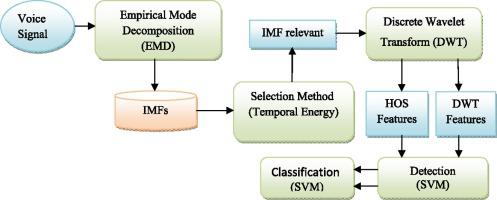IRBM ( IF 5.6 ) Pub Date : 2020-01-06 , DOI: 10.1016/j.irbm.2019.11.004 I. Hammami , L. Salhi , S. Labidi

|
Background
The voice is a prominent tool allowing people to communicate and to change information in their daily activities. However, any slight alteration in the voice production system may affect the voice quality. Over the last years, researchers in biomedical engineering field worked to develop a robust automatic system that may help clinicians to perform a preventive diagnosis in order to detect the voice pathologies in an early stage.
Method
In this context, pathological voice detection and classification method based on EMD-DWT analysis and Higher Order Statistics (HOS) features, is proposed. Also DWT coefficients features are extracted and tested. To carry out our experiments a wide subset of voice signal from normal subjects and subjects which suffer from the five most frequent pathologies in the Saarbrücken Voice Database (SVD), is selected. In The first step, we applied the Empirical Mode Decomposition (EMD) to the voice signal. Afterwards, among the obtained candidates of Intrinsic Mode Functions (IMFs), we choose the robust one based on temporal energy criterion. In the second step, the selected IMF was decomposed via the Discrete Wavelet Transform (DWT). As a result, two features vector includes six HOSs parameters, and a features vector includes six DWT features were formed from both approximation and detail coefficients. In order to classify the obtained data a support vector machine (SVM) is employed. After having trained the proposed system using the SVD database, the system was evaluated using voice signals of volunteer's subjects from the Neurological department of RABTA Hospital of Tunis.
Results
The proposed method gives promising results in pathological voices detection. The accuracies reached 99.26% using HOS features and 93.1% using DWT features for SVD database. In the classification, an accuracy of 100% was reached for “Funktionelle Dysphonia vs. Rekrrensparese” based on HOS features. Nevertheless, using DWT features the accuracy achieved was 90.32% for “Hyperfunktionelle Dysphonia vs. Rekurrensparse”. Furthermore, in the validation the accuracies reached were 94.82%, 91.37% for HOS and DWT features, respectively. In the classification the highest accuracies reached were for classifying “Parkinson versus Paralysis” 94.44% and 88.87% based on HOS and DWT features, respectively.
Conclusion
HOS features show promising results in the automatic voice pathology detection and classification compared to DWT features. Thus, it can reliably be used as noninvasive tool to assist clinical evaluation for pathological voices identification.
中文翻译:

基于高级统计特征的EMD-DWT分析语音病理分类与检测
背景
语音是使人们在日常活动中进行交流和更改信息的杰出工具。但是,语音产生系统中的任何细微变化都可能影响语音质量。在过去的几年中,生物医学工程领域的研究人员致力于开发一种强大的自动系统,该系统可以帮助临床医生进行预防性诊断,以便在早期阶段检测出语音病理。
方法
在此背景下,提出了一种基于EMD-DWT分析和高阶统计量(HOS)特征的病理语音检测与分类方法。还提取并测试了DWT系数特征。为了进行我们的实验,选择了来自正常受试者和遭受萨尔布吕肯语音数据库(SVD)中五个最常见病理的受试者的语音信号的广泛子集。在第一步中,我们将经验模式分解(EMD)应用于语音信号。然后,在获得的本征模式函数(IMF)候选对象中,我们根据时间能量准则选择一种健壮的函数。第二步,通过离散小波变换(DWT)分解选定的IMF。结果,两个特征向量包含六个HOS参数,包含六个DWT特征的特征向量是由近似系数和细节系数构成的。为了对获得的数据进行分类,采用了支持向量机(SVM)。在使用SVD数据库训练了建议的系统之后,使用来自突尼斯RABTA医院神经科的志愿者受试者的语音信号对系统进行了评估。
结果
所提出的方法在病理性语音检测中提供了有希望的结果。使用HOS功能,对于SVD数据库,使用DWT功能的精度达到99.26%。在分类中,基于居屋功能,“ Funktionelle Dysphonia vs. Rekrrensparese”的准确性达到100%。但是,使用DWT功能,“ Funkerfunktionelle Dysphonia vs. Rekurrensparse”的准确率达到了90.32%。此外,在验证中,HOS和DWT功能的准确率分别为94.82%,91.37%。在分类中,根据HOS和DWT特征分别将“帕金森与瘫痪”分类的最高准确率分别为94.44%和88.87%。
结论
与DWT功能相比,HOS功能在自动语音病理检测和分类中显示出令人鼓舞的结果。因此,它可以可靠地用作非侵入性工具,以帮助进行病理性声音识别的临床评估。










































 京公网安备 11010802027423号
京公网安备 11010802027423号